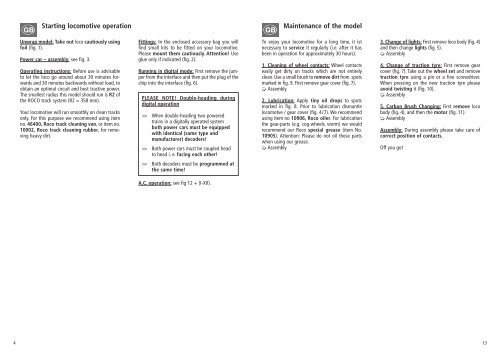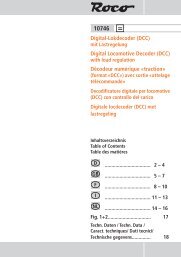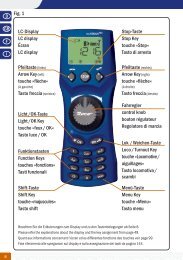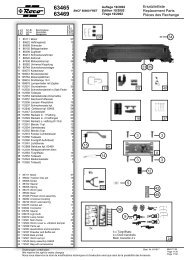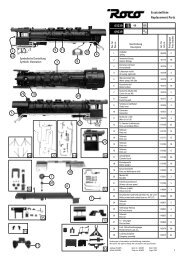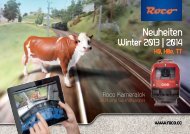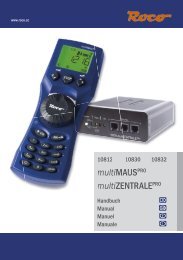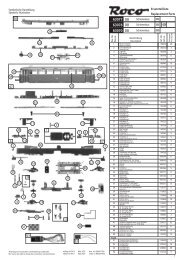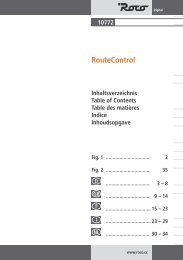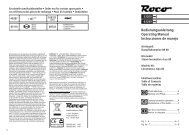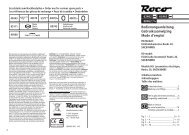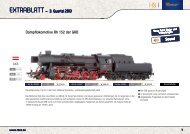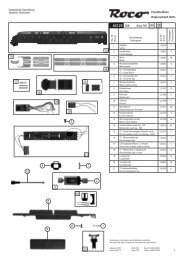Roco 41260... 16stg.
Roco 41260... 16stg.
Roco 41260... 16stg.
You also want an ePaper? Increase the reach of your titles
YUMPU automatically turns print PDFs into web optimized ePapers that Google loves.
GB<br />
Starting locomotive operation<br />
GB<br />
Maintenance of the model<br />
Unwrap model: Take out loco cautiously using<br />
foil (fig. 1).<br />
Power car – assembly: see fig. 3.<br />
Operating instructions: Before use is advisable<br />
to let the loco go around about 30 minutes forwards<br />
and 30 minutes backwards without load, to<br />
obtain an optimal circuit and best tractive power.<br />
The smallest radius this model should run is R2 of<br />
the ROCO track system (R2 = 358 mm).<br />
Your locomotive will run smoothly on clean tracks<br />
only. For this purpose we recommend using item<br />
no. 46400, <strong>Roco</strong> track cleaning van, or item no.<br />
10002, <strong>Roco</strong> track cleaning rubber, for removing<br />
heavy dirt.<br />
Fittings: In the enclosed accessory bag you will<br />
find small kits to be fitted on your locomotive.<br />
Please mount them cautiously. Attention! Use<br />
glue only if indicated (fig. 2).<br />
Running in digital mode: First remove the jumper<br />
from the interface and then put the plug of the<br />
chip into the interface (fig. 6).<br />
PLEASE NOTE! Double-heading during<br />
digital operation<br />
>> When double-heading two powered<br />
trains in a digitally operated system<br />
both power cars must be equipped<br />
with identical (same type and<br />
manufacturer) decoders!<br />
>> Both power cars must be coupled head<br />
to head i. e. facing each other!<br />
>> Both decoders must be programmed at<br />
the same time!<br />
To enjoy your locomotive for a long time, it ist<br />
necessary to service it regularly (i.e. after it has<br />
been in operation for approximately 30 hours).<br />
1. Cleaning of wheel contacts: Wheel contacts<br />
easily get dirty on tracks which are not entirely<br />
clean. Use a small brush to remove dirt from spots<br />
marked in fig. 9. First remove gear cover (fig. 7).<br />
➭ Assembly<br />
2. Lubrication: Apply tiny oil drops to spots<br />
marked in fig. 8. Prior to lubrication dismantle<br />
locomotve / gear cover (fig. 4/7). We recommend<br />
using item no 10906, <strong>Roco</strong> oiler. For lubrication<br />
the gear-parts (e.g. cog-wheels, worm) we would<br />
recommend our <strong>Roco</strong> special grease (item No.<br />
10905). Attention: Please do not oil these parts<br />
when using our grease.<br />
➭ Assembly<br />
3. Change of lights: First remove loco body (fig. 4)<br />
and then change lights (fig. 5).<br />
➭ Assembly<br />
4. Change of traction tyre: First remove gear<br />
cover (fig. 7). Take out the wheel set and remove<br />
traction tyre using a pin or a fine screwdriver.<br />
When pressing on the new traction tyre please<br />
avoid twisting it (fig. 10).<br />
➭ Assembly<br />
5. Carbon Brush Changing: First remove loco<br />
body (fig. 4), and then the motor (fig. 11).<br />
➭ Assembly<br />
Assembly: During assembly please take care of<br />
correct position of contacts.<br />
Off you go!<br />
A.C. operation: see fig 12 + (I-XII).<br />
4 13


